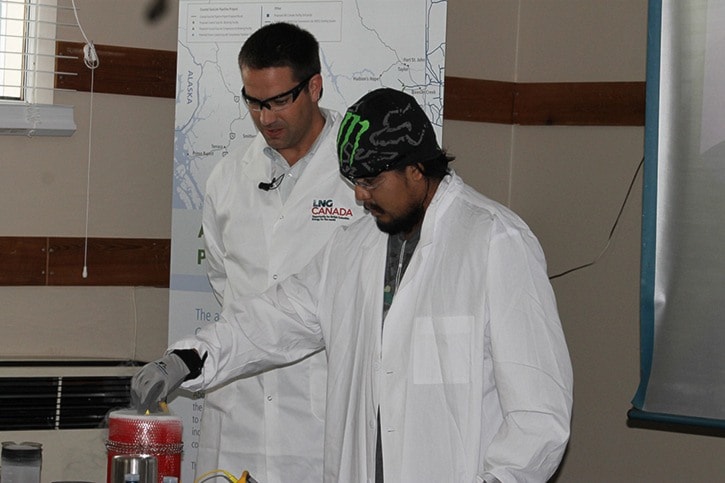TransCanada held a liquefied natural gas (LNG) demonstration event at the Heritage Centre in Burns Lake on Oct. 23, 2014.
The meeting provided the audience with an up-close look on how LNG is produced, transported and used. Community members filled up the room and paid close attention while experts demonstrated LNG's physical properties and behaviours using real LNG - a natural gas that has been converted to a liquid form for storage or transportation.
TransCanada's experts asked the public to assist them during their presentation, demonstrating what natural gas looks like when it reacts to different scenarios such as being in contact with water. The event included a question and answer period at the end, and the filming of a TransCanada's documentary.
Speakers discussed their Coastal GasLink Pipeline project, a 650-kilometre pipeline from the Dawson Creek area to the west coast of B.C., passing south of Burns Lake. The pipeline will transport natural gas to the proposed LNG Canada facility near Kitimat.
Coastal GasLink Pipeline Ltd. is a wholly owned subsidiary of TransCanada PipeLines LTD.
The project was first announced on June 5, 2012. On Oct. 24, 2014, TransCanada announced that the B.C. Environmental Assessment Office (EAO) has issued an Environmental Assessment Certificate for the Coastal GasLink Pipeline Project. The certificate was issued with a number of conditions resulting from the assessment by the EAO of environmental, social, economic, heritage and health components deemed pertinent to the project.
The regulatory process in British Columbia focuses on identifying the potential adverse environmental effects of a proposed project, and outlining the mitigation required to manage such effects. The Coastal GasLink pipeline will require various federal, provincial and local government permits.
"British Columbia's environmental assessment process involves a rigorous, thorough review that provides for significant opportunities for First Nations, government agencies and the public to provide input on the potential for environmental, economic, social, heritage and health effects from a proposed project," said the Ministry of Environment in a press release.
Next steps for Coastal GasLink in 2015 include detailed engineering and construction planning as well as ongoing consultation with Aboriginal groups and the public. Pending the receipt of the required regulatory approvals and a positive final investment decision from LNG Canada, the start of pipeline construction is anticipated in 2016, with an in-service date by the end of the decade.
Estimated at approximately $4 billion, the construction of the pipeline would create 2000-2500 direct jobs over a three-year construction period.
TransCanada, an energy infrastructure company, operates one of North America's largest natural gas networks - 68,500 km transporting approximately 20 per cent of North America's daily natural gas needs.
